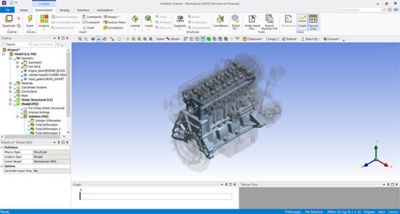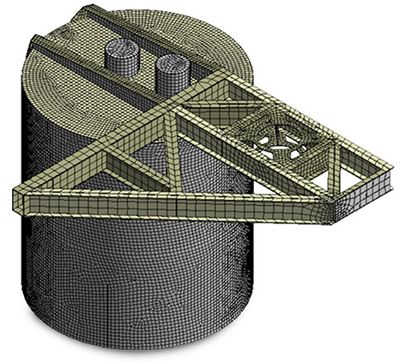-
United States -
United Kingdom -
India -
France -
Deutschland -
Italia -
日本 -
대한민국 -
中国 -
台灣
-
Ansys는 학생들에게 시뮬레이션 엔지니어링 소프트웨어를 무료로 제공함으로써 오늘날의 학생들의 성장을 지속적으로 지원하고 있습니다.
-
Ansys는 학생들에게 시뮬레이션 엔지니어링 소프트웨어를 무료로 제공함으로써 오늘날의 학생들의 성장을 지속적으로 지원하고 있습니다.
-
Ansys는 학생들에게 시뮬레이션 엔지니어링 소프트웨어를 무료로 제공함으로써 오늘날의 학생들의 성장을 지속적으로 지원하고 있습니다.
ANSYS BLOG
April 14, 2020
3 Amazing Structural Analysis Examples for Engineers
Since the debut of Ansys’ structural mechanics solutions in 1969, engineers have relied on structural analysis software to optimize their designs and validate their products.
Ansys simulation technology continues to evolve to meet the needs of engineers who use simulation software to create innovative products, systems and processes.
The Ansys Mechanical user interface
So, without further ado, here are three structural analysis examples that highlight the importance of simulation software.
For history on Ansys Mechanical, read: Making the Best in Class Even Better. For a look into Mechanical’s future, read: Structure a New Industry Standard.
Structural Analysis Example of How Engineers Design Parts for Additive Manufacturing
These bicycle frame parts need to align if they are to fit into the assembly. This can
be a challenge when engineers produce the parts using additive manufacturing.
Ansys Additive Print reduces distortions enabling the part to be built
properly the first time.
Rosswag later introduced Ansys Additive Print into the development cycle to help predict the internal stresses of the part and how the printing material would perform.
By predicting the distortions and stresses using this simulation process, Rosswag successfully optimized its designs to compensate. As a result, the development time reduced by months and the parts printed properly on the first build.
To learn more about how Rosswag achieved this, read: Reducing the Strain of Additive Manufacturing.
The History of Hallquist’s Creation of a Structural Analysis Tool for Nonlinear Dynamics
With the acquisition of Livermore Software Technology Corporation (LSTC), Ansys users will benefit from increased multiphysics compatibility between the Ansys portfolio and the nonlinear dynamics solver of LS-DYNA. This enables engineers to study systems that experience severe material deformation, or failure, over a short timeframe.
Ansys LS-DYNA created this car crash simulation.
John Hallquist began creating LS-DYNA in 1976 at Lawrence Livermore National Laboratory to code a solver with explicit time integration that could study nonlinear dynamics. The software’s success led to the creation of LSTC in 1987 — with LS-DYNA serving as the flagship product.
Hallquist and LSTC continued to improve the software to support other analysis methods including:
- Arbitrary Lagrangian Eulerian method
- Incompressible computational fluid dynamics (CFD)
- Conservation element/solution compressible fluids
- Discrete element method (DEM)
- Electromagnetism
- Element-free Galerkin method
- Fluid–structure interaction (FSI)
- Implicit simulations
- Noise, vibration and harshness (NVH)
- Smooth particle hydrodynamics
- Heat transfer
To learn more of the history of LS-DYNA and how its various functionalities will fit into the Ansys portfolio, read: Ansys and LS-DYNA Creator Livermore Software Technology Corporation Sign Definitive Acquisition Agreement.
This Structural Analysis Example Piles on the Material Savings
Suction piles are a fascinating offshore mooring technology. These devices are essentially a cylinder with one end open. This involved placing the pile on the seabed, suction the water out of the structure and use that differential under pressure to push the device into the soil.
Once the pile enters the soil, it provides a strong anchor for offshore drilling, exploratory vessels, windmills and anything else that needs to remain stationary in water and above 3000m.
The mesh of a suction pile
The stronger the soil, the better stability it offers. However, that also means that engineers need to ensure the suction pile can withstand more pressure as it digs into the soil.
Traditionally, engineers simulated the system using radial springs with nonlinear stiffness. This created a conservative solution that used a lot of expensive steel to create the structure.
To address this challenge, Ansys elite channel partner EDRMedeso used Ansys Mechanical to simulate the system using finite element analysis (FEA) and the geomechanics library. They saved their client over $280,000 in material costs without risking the performance of the pile.
Any and all ANSYS, Inc. brand, product, service and feature names, logos and slogans such as Ansys, Ansys Additive Print, Ansys LS-DYNA, Ansys Mechanical are registered trademarks or trademarks of ANSYS, Inc. or its subsidiaries in the United States or other countries.














